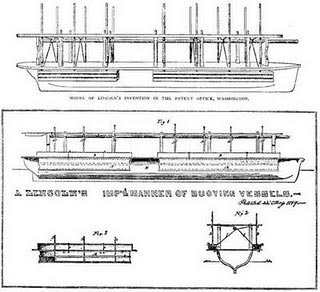
Nantucket Camel Ride
In the United States, today is “Presidents’ Day,” a national holiday on the third Monday of February, falling between Lincoln’s (February 14th) and Washington’s (February 22) birthdays. Here is a repost of the tale of Lincoln’s camel that we ran back in 2010.
In the early 1800s, the entrance to the harbor of the great whaling port of Nantucket had shoaled in. Fully loaded whaling ships could not cross the bar and return to the docks beyond Brandt Point. For years the ships anchored offshore and were lightered, the barrels of whale oil loaded into smaller boats which could make it across the bar. To avoid the considerable time and expense of lightering, an ingenious group of Nantucketers built a camel, which consisted of a pair barges of hollow barges connected by chains, which acted as a floating drydock to lift the whaling ship up and over the bar. The twin barges were partially filled with water, then brought on either side of the whaling ship. The chains between them were tightened and the barges were pumped dry. The buoyancy of the “camel” would lift the whaling ship so the camel and the ship together could cross the bar. The first ship to ride “over the bar” on the camels was the 257-ton whaler, Peru, returning in 1839, from a successful, 3-1/2 year, voyage in the Pacific. Nantucket’s own Joshua Coffin commanded the ship right up to the wharf, the proud captain bringing his ship, cargo and crew all the way home.
So what does this have to do with Abraham Lincoln? Lincoln is the only US President to have ever been granted a patent. He invented an improved camel to lift boats and ships over sandbars.
Abraham Lincoln’s Patent Model: Improvement for Buoying Vessels Over Shoals
On May 22, 1849, he was granted Patent No. 6469 by the U.S. Patent Office (USPO) in Washington, D.C. This boat model, submitted with the drawings of his idea, is inscribed “Pat./May 22/49/Abram Lincoln” on the surface of the upper deck. According to a Lincoln biographer, the President visited the Patent Office during his presidency (1861–1865) and inspected his model. His considerable talents lay elsewhere, and the idea he patented was never formally applied in the construction of a watercraft.


This was common in the port of Amsterdam. Here are some pictures of models from the maritime museum in Rotterdam and the Rijksmuseum in Amsterdam:
https://plus.google.com/photos/search/amsterdam%20camel?hl=en_US&pid=5889158328468902898&oid=117173072934335742431
https://plus.google.com/photos/search/amsterdam%20camel?hl=en_US&pid=5896140658434191586&oid=117173072934335742431
https://plus.google.com/photos/search/amsterdam%20camel?hl=en_US&pid=5896140646480334306&oid=117173072934335742431
Thanks Louis.